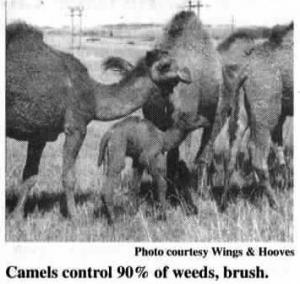1995 - Volume #19, Issue #5, Page #33
[ Sample Stories From This Issue | List of All Stories In This Issue | Print this story
| Read this issue]
Ranches Use Camels To Control Weeds, Brush
 |
"We imported a few dromedary (one hump) camels from Australia in 1989 to see if they would clean up brush," explains Keith Meyer, executive manager of Hudson Ranches, based in Topeka, Kan. "It worked so well we now have 40 camels on seven ranches in Missouri, Kansas and Texas. They're 90% effective on woody weeds such as thistle and ragweed and/or brush including sprouting mesquite trees. They do as good a job as chemicals and are easy to care for, requiring no more work than a big cow. They eat the same things as beef cattle - hay, cracked corn and dehydrated alfalfa pellets. They're easy to train, learning to move from one pasture to another faster than cattle."
Camels are difficult to domesticate unless bottle-fed from birth. And an isolated camel won't move by itself so they always have to be handled in groups.
Still, they come naturally equipped for brush and weed control. An extremely tough lining in their mouths allows them to chow down on stems of brush and woody weeds.
Besides controlling weeds and brush, the camels may provide an additional benefit around the ranch. Predators like coyotes haven't been a problem since they arrived at one of the Texas ranches.
That might be because of their formidable size - adults stand 6 to 7 ft. high at the shoulder and weigh from 600 to 1,500 lbs. It might also be their 34 big sharp teeth and their often ornery disposition.
Camels have long, matted coats during the winter and spring. Hair on their humps and heads sheds in hot weather. They have been clocked at speeds of over 40 mph when in pursuit. They live to be about 40 years of age. Gestation period is 370 to 440 days.
Contact: FARM SHOW Followup, Keith Meyer, Hudson Ranches, 1200 Bank IV Tower, Topeka, Kan. 66603.

Click here to download page story appeared in.

Click here to read entire issue
To read the rest of this story, download this issue below or click here to register with your account number.




